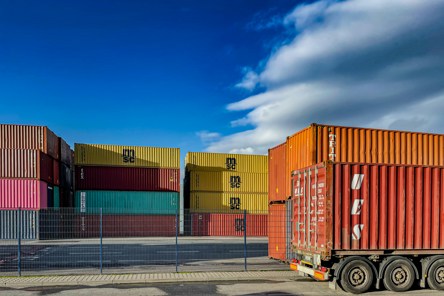Supply chain uncertainty became a worldwide concern during the 2020 pandemic and continues to be a problem in 2024. According to one survey, 62% of participants missed their 2023 targets, falling from 2022 and 2021 after a brief rebound following the pandemic.
You can build a more resilient supply chain, though, and stand out from the crowd that’s still struggling with issues like severe weather, natural disasters, and disruptive military conflicts. Here’s what you need to know about supply chain resilience and how the right logistics experts can help.
Strategies for Building Resilience in Supply Chains
Let’s start with some essential strategies that any business can use to build supply chain resilience.
First, diversifying suppliers is vital, in case one source is hit by war or a natural disaster, goes under, or loses their own raw materials suppliers. We recommend diversifying by company and by region, for the reasons just suggested. For some companies, that entails making more parts in-house or nearshoring.
Additionally, supply chain predictive analytics can help businesses with risk mitigation through advance warnings of trouble (political turmoil, severe weather patterns, economic downturns, etc.). This means monitoring on a number of fronts, particularly those most relevant to your operations.
Third, since supply chain issues became so much worse during the recent pandemic, the plan of increasing inventory has become a wise one. Real-time inventory tracking, diversifying fulfillment centers, and staying ahead of heavy demand periods are key here.
SEKO Logistics can help clients with all these supply chain resilience strategies through:
-
Warehousing
-
Global fulfillment
-
International cross-border shipping
-
MySEKO monitoring
How Does Transparency Enhance Accountability, Trust, And Compliance While Reducing Risks?
MySEKO is a web-based software solution that SEKO Logistics clients can access through a user-friendly dashboard. It allows them to book shipments and track shipments in real time, among other functions.
This is one supply chain risk management strategy that also fosters accountability, trust, and compliance. When you can see everything easily in one place and make data-driven decisions, you improve efficiency and have a better chance of avoiding supply chain disruptions.
What Are The Supply Chain Resilience Strategies For Mitigating Disruptions And Uncertainties?
Other supply chain disruption mitigation strategies include using flexible logistics frameworks and diversified supply routes. It’s not enough to only source from multiple places.
Because SEKO Logistics works with a global network, we can offer resilient supply chain strategies that let us quickly adjust supply routes in times of uncertainty due to storms, international conflicts, or issues like ships blocking major canals, like in the 2021 Suez Canal Crisis. Our goal is to minimize uncertainty with constant monitoring and the agility to make immediate changes as needed.
Approaches to Strengthen Business Resilience in Supply Chains to Withstand Disruptions
We’ve touched a bit above on building resilience into your supply chain. Some other suggestions we make include:
-
Employing flexible inventory management
-
Keeping buffer stock available for emergencies
-
Using algorithms to predict peak demand times
-
Supplementing longer shipping methods with air freight
-
Maintaining robust and diverse supplier relationships
-
Reviewing past events to pinpoint and fix vulnerabilities
Essential Components of a Resilient Supply Chain
So based on the strategies above, what are the key elements you and your logistics partners must have to enjoy a resilient supply chain?
-
Proper risk assessment, using both AI technology and human analysis
-
Diversified suppliers in a variety of geographic locations
-
Real-time data monitoring to identify issues before they morph into worse scenarios
When you collaborate with SEKO Logistics, you benefit from our combination of advanced technology and global reach. This has historically supported and continues to support our clients in building the strongest supply chains possible. Your business can also become a supply chain leader with these tactics.
How Can We Mitigate Natural Disasters In Supply Chains?
Supply chains can become fragile due to many factors, not the least of which lately is severe weather and natural disasters, including:
-
Hurricanes, typhoons, and tornados
-
Storm surges and flooding
-
Snowstorms and freezing temperatures
-
Extreme heat emergencies
-
Earthquakes and tsunamis
Therefore, disaster-proof logistics solutions are necessary to survive and thrive in today’s global market. In addition to diversifying suppliers, as discussed above, other logistics disaster preparedness strategies include:
-
Developing a plan for business continuity in logistics emergencies caused by natural disasters
-
Having a plan B — options for crisis management in supply chains under duress
-
Creating a supply chain disruption recovery plan to get back on track as quickly as possible
Ideally, you want to work with your logistics experts to use predictive analytics to avoid a natural disaster causing disruption in the first place. As Mr. Miyagi told the Karate Kid, “Best defense is no be there.” Or as the old adage goes, “An ounce of prevention is worth a pound of cure.”
Key Risk Mitigation Strategies in Supply Chain Management
Risk mitigation strategies for logistics can be complex and involve both micro and macro influences. To summarize, the three most important strategies are:
-
Conduct meticulous and ongoing risk analysis.
-
Develop flexible supplier and logistics networks.
-
Create plans to handle emergencies, should they arise.
SEKO’s Role in Ensuring Transparency in Supply Chain Management Services
Is your business looking for a logistics partner that practices transparency and can help you build a resilient supply chain? SEKO Logistics has real-time tracking capabilities through MySEKO, detailed reporting systems, and end-to-end visibility that can reduce risks, improve decision-making, and work with you to disaster-proof your inventory and shipments.
Our services include:
-
Warehousing
-
Freight forwarding
-
Last-mile solutions
-
Ocean and air transportation
-
Customs clearance
We understand every business is unique. That’s why we invite you to start a one-on-one conversation to discuss how SEKO can transform your logistics. Reach out to get the discussion going, and get the peace of mind you desire when it comes to managing your supply chain.





